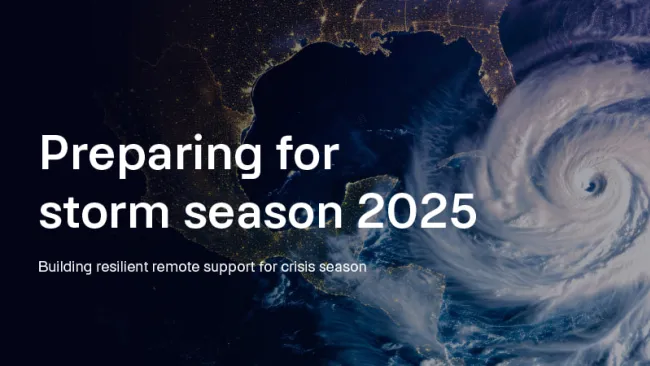The COVID-19 crisis has posed not just a health threat, but an unprecedented global economic threat as well. Still, as Albert Einstein once famously said, “In the midst of crisis lies great opportunity.”
Consider, for instance, that in 2020 alone, the volume of e-commerce in the U.S. grew by more than 40%, compared to an average annual growth rate in the low teens over the previous two decades. Moreover, most of this dramatic acceleration in e-commerce occurred within just the first three months of lockdowns and social distancing!
Businesses in all industries around the world have had to radically accelerate whatever digital plans they already had on their shelves. Large, bureaucratic companies could no longer patiently treat their digital transformation task as just one more “initiative du jour.” Instead, COVID-19 forced even the slowest moving organizations to sweep obstacles aside and focus intently on putting new tools and technologies to use immediately, with no other feasible option than to trust and empower lower-level workers to ease the disruptions and solve the problems posed by these tools and technologies on their own initiative.
One lesson that businesses have learned from all the frenetic activity undertaken during the first year of the pandemic is that “agile” management principles are no longer just for software vendors and startups. Agility is quickly and gratefully embraced by any organization wishing to survive a dramatic, unforeseen existential threat, and the results have been remarkable. According to Harvard Business School’s Amy Edmondson, “The shift has happened in days, not months. Businesses may be able to learn faster, acting in more agile ways, as a result.” Indeed, McKinsey reports that one global telecom company was able to redeploy a thousand in-store workers and turn them into a home-based inside sales force in just three weeks, while a large U.S. retailer instituted curbside pickup in just two days, rather than their previously planned 18 months. Or think about the last time you used cash to pay for something.
Contactless payment systems are surging, while increasing numbers of stores and restaurants are no longer even accepting cash.
The crisis has also exposed the downside fragilities of all the various efficiencies we’ve built into our economic system over the years. Maybe you’ve wondered, for instance, why toilet paper and paper towels could have suddenly become so scarce as to have to be rationed by your local supermarket, or why such shortages continue to persist almost a full year into this crisis. But as the Wall Street Journal has reported, “The scarcity is rooted in a decades-long quest by businesses at all levels, handling many different products, to eke out more profit by operating with almost no slack. Make only what you can sell quickly. Order only enough materials to keep production lines going. Have only enough railcars for a day’s worth of output.”
But human waste is surely a constant, you might think, so how could the pandemic possibly require greater factory capacity or more railcars just to get enough toilet paper into stores? But remember that the kind of toilet paper dispensed in business restrooms is quite different from the Charmin, Cottonelle, or Quilted Northern you use at home. This mismatch means that the sudden steep increase in work-at-home and school-at-home activity has given us a long-lingering shortage of toilet paper for home use, while we have a still-growing growing oversupply of toilet paper for offices, schools, restaurants, and other public places.
In the short term (and most business organizations suffer greatly from short-termism), economic self-interest motivates businesses to streamline their operations and reduce the variability in their processes. Such activities are designed to minimize errors, reduce costs and improve profits (think “Six Sigma”). But the less variability you have in your processes, the more fragile those processes will become when faced with unforeseen changes or disruptions, whether those come from pandemics, sudden economic meltdowns, terrorist attacks, or asteroid impacts. As the mathematical statistician Nicholas Nassim Taleb has warned, “We have been fragilizing the economy, our health, political life, education, almost everything…by suppressing randomness and volatility.”
A number of enterprising businesses have also been catering to customer needs and desires specifically related to the crisis. Obviously, direct-to-consumer businesses have thrived, as well as businesses that facilitate direct-to-consumer orders and deliveries. Nor is Zoom the only online connection and interaction tool that has flourished. Peloton’s high-end exercise equipment business has tripled, linked to its customers’ access to live streaming and on-demand exercise classes. Or consider Netflix’s Teleparty extension for Chrome, which allows you to synchronize the viewing of shows on Netflix, HBO, Hulu, and Disney with your friends – dozens of friends at a time if you like – and to interact in real time using a window built into the app for side comments and chats.
Despite all the angst and disruption, and notwithstanding the health threats, job losses, and misery unleashed by COVID, we should all take comfort in one overriding fact: Sooner or later, the COVID pandemic will pass, while the digital innovations, adaptations, and customer-experience improvements forced on all businesses during the crisis will remain with us for decades to come.
But let’s also hope that as the end-of-crisis daylight returns, future businesses will find the courage to rely less on the kind of inflexible, short-term economic thinking and planning that has already done so much avoidable damage. And short-termism is the arch enemy of customer experience management, so we might also see a long-term uptick in companies’ concerns for the quality of the customer experience.
















